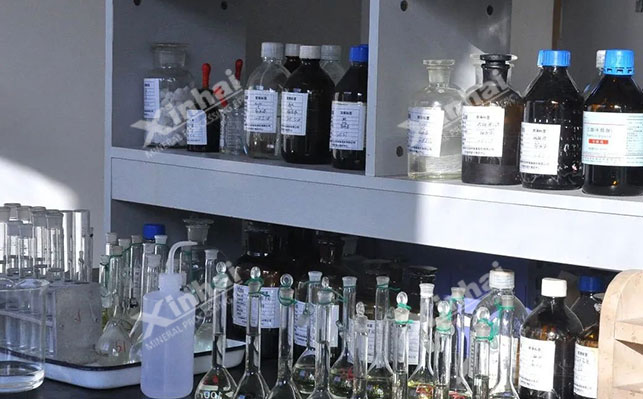
15311826613
Click to add WeChatWhen dealing with the flotation process of copper-lead-zinc sulfide ores, it is necessary to first conduct in-depth research on the composition and structural characteristics of the ore to determine the intercalation relationship of the main metal minerals in the ore and the intercalation characteristics of the copper minerals. Based on this information, a suitable copper-lead-zinc flotation separation process can be designed. The following is a detailed introduction to the four major copper-lead-zinc flotation processes:
The priority flotation process is suitable for ores with simple composition, high ore grade, and large differences in the floatability of useful minerals. The process includes:

Copper ore flotation:First, add an inhibitor to suppress the floatability of lead and zinc minerals, then add a collector to promote the combination of copper minerals and bubbles, and then add a frother to stabilize the foam layer to complete the separation of copper concentrate. The amount of reagents added, pH value and temperature need to be controlled during operation.
Lead ore flotation:After copper ore flotation, add an inhibitor to the slurry to suppress the floating of zinc minerals, use a collector to capture lead minerals, and add a frother to stabilize the foam layer to separate the lead concentrate. The operation needs to be strictly controlled to improve the recovery rate and grade.
Zinc ore flotation:Copper sulfate is used as an activator to improve the floatability of zinc ore, and then a collector is added to capture the zinc ore, and then a frother is added to make it float and separate the zinc concentrate. Effective separation is achieved by adjusting the dosage of reagents and the conditions of the flotation tank.
It is suitable for polymetallic ores where useful minerals are unevenly embedded or densely intergrown with each other, or one useful mineral is finely embedded in another mineral, and its intergrowth, coarser embedded in the gangue. The process includes:

Mixed flotation stage:Add collectors and frothers, copper, lead and zinc minerals float together to form mixed concentrate, completing the initial enrichment.
Mixed concentrate decontamination:Through mechanical decontamination (multiple selection, regrinding, concentration, scrubbing, filtering and washing), desorption (using sodium sulfide and activated carbon) and heating method, remove the reagent film on the mineral surface and the excess reagent in the slurry.
Separation stage: Adjust the pH value of the slurry and the collector (such as xanthate, butyl xanthate and black medicine) in stages to achieve the flotation and separation of copper, lead and zinc minerals in turn.
Applicable to copper, lead and zinc polymetallic sulfide ores with similar floatability. The process includes:

Mixed flotation of copper and lead: Ensure the appropriate pH value of the slurry through lime slurry adjustment. Ty-1 and zinc sulfate are used as inhibitors, ethyl xanthate and J-21 are used as collectors to achieve effective separation of zinc minerals from copper and lead minerals, ensure moderate foam viscosity, and create conditions for the next step of copper-lead separation.
Copper and lead separation: The method of suppressing lead and flotation of copper is adopted, and ethyl oil and 2# oil are used as collectors and frothers to obtain high-grade copper concentrate. Subsequently, the grade of lead concentrate is improved by gravity separation shaker, and inhibitors such as cyanide and oxygen sulfur method are selected according to the type of mineral to adjust the flotation reagent.
Tailing zinc selection: The tailings of copper-lead mixed flotation are roughly selected, and lime, copper sulfate, butyl xanthate and 2# oil are used to adjust the flotation pH value to obtain high-grade zinc concentrate. Subsequently, two concentrations and one scavenging are carried out to ensure the improvement of the grade of zinc concentrate.
Following the principle of "easy first, difficult later", the minerals to be recovered are divided into two parts, easy to float and difficult to float, according to the difference in natural floatability, and mixed flotation is performed to obtain mixed concentrate, and then copper, lead, and zinc concentrates are separated in turn. The process includes:

Mixed flotation stage of easy-floating minerals: The flotation of easy-floating minerals is improved by the natural flotation of minerals or collectors, and preferential flotation is performed to form a preliminary mixed concentrate.
Mixed flotation stage of difficult-to-float minerals:By adding sulfiding agents and adjusting pH values, the floatability of difficult-to-float minerals is improved to obtain mixed concentrates of difficult-to-float minerals.
Separation stage:Copper concentrate is obtained by activating copper minerals with copper sulfate, collecting xanthate and frothing with frothers; lead concentrate is obtained by adding inhibitors, collecting black medicine and frothing with frothers; and zinc concentrate is obtained by activating zinc minerals with copper sulfate, collecting sulfur and nitrogen collectors and frothing with frothers, and effective separation of copper, lead and zinc minerals is achieved in turn.
Through a comprehensive understanding of the four major copper, lead and zinc flotation processes, we can see that when processing copper, lead and zinc sulfide ores, choosing a suitable flotation process is crucial to improving the recovery rate and grade of the ore. Whether it is priority flotation, mixed priority flotation, partially mixed priority flotation or equal flotation process, each process has its applicable ore characteristics and operating points. In actual production, it is necessary to flexibly select and adjust the flotation process according to the composition, structural characteristics and changes in process conditions of the ore to achieve the goals of economy, efficiency and environmental protection.